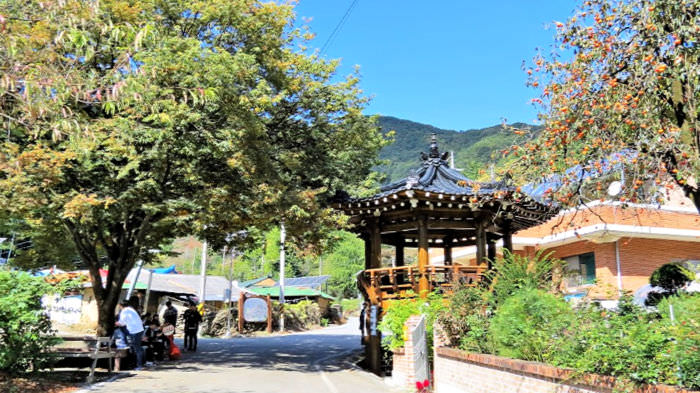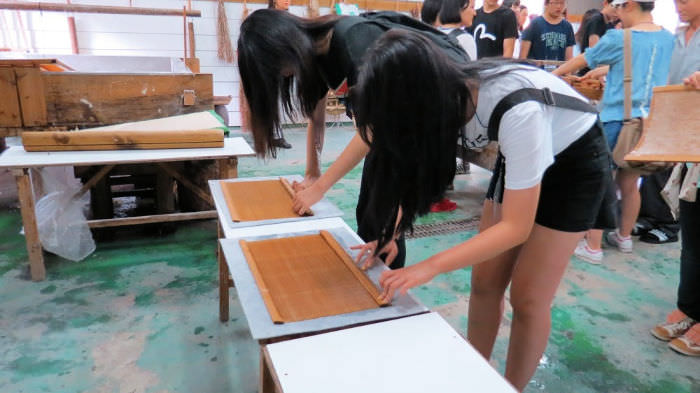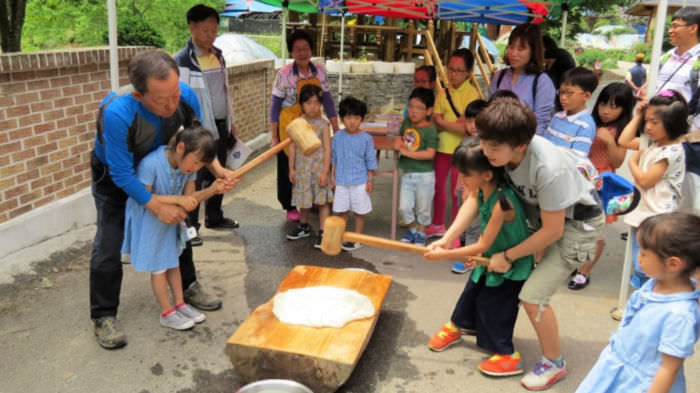Traditional Beollat Hanji Village
 Traditional Beollat Hanji Village - A hanji paper can be made with various designs, such as the above photo
Traditional Beollat Hanji Village - A hanji paper can be made with various designs, such as the above photoTraditional Beollat Hanji Village
The traditional Beollat Hanji Village (벌랏한지마을) is a famous area that manufactures and promotes the Korean paper known as 'hanji'.
Children and adults from the neighboring towns and from other places visit the village to learn, explore, and relax with the facilities available.
During the Imjin War (1592-1598), it was a place for refuge and settlement and refufees lived for a long time. Then later on, it became a town popular for producing Korean paper with materials from mulberry trees.
The traditional Beollat hanji village is a valley which turned into its present developed area. It used to be surrounded by upland farming fields and some wet rice fields.
 Entrance to Beollat (Bulat) Hanji Village (photo: Beollat website)
Entrance to Beollat (Bulat) Hanji Village (photo: Beollat website)The Beollat Hanji Village is one of the few environmentally-friendly areas in Korea where nature and human beings live harmoniously.
If you visit, you will notice that you cannot find newly-built buildings or the so-called "development" projects that amounts to sacrificing the natural world.
The water resource in the village is well-preserved by its natural environment and is being protected by the villagers. The surrounding mountains help preserve the nature and the natural beauty of the village itself.
Hanji Paper
 Hanji paper is commonly used in making lanterns
Hanji paper is commonly used in making lanternsHanji is also commonly referred to as the Joseon Paper. Hanji paper is made from the bark of mulberry [楮] or cedar mulberry [三 枝 楮].
The Hanji makers collect the barks of these trees, bundle them, and placed in a cauldron. The cauldron should contain water to boil the barks until the peel is soft and come off.
They then squeeze soft peels and then mix with lye and boil again for more than three hours. Finally, they squeeze the water out from the skins with a compressor.
Then the process will involve mixing the sticky water made from the mulberry roots. They need to combine both the peels and sticky water thoroughly to get the best-mixed result.
 Youngsters enjoying the Hanji paper-making activity
Youngsters enjoying the Hanji paper-making activityThe result would be that the peels will loosen and spread evenly. They then let dry the mixture through a filter, which involved stepping on them.
The quality of Hanji varies depending on its purpose. For example, it can be used to cover doors, cover or shade windows, genealogy document use, Buddhist scriptures writing, and manuscripts or papers of various sorts.
Also, Hanji is used as Taeji (苔 紙), which is specially made for wedding invitations, among others. This exceptional paper has a fluffy and mossy texture and surface.
 Hanji is also used to make invitation letters, e.g., wedding invitations
Hanji is also used to make invitation letters, e.g., wedding invitations Haji is a common material used for making indoor lanterns.
Haji is a common material used for making indoor lanterns.Traditional Village Experience
Beollat Hanji Village does not have many flush toilets. You cannot find supermarkets, and cell phones don't get clear signals.
It is a remote village where only the starlight shines at night.
It is only one of the villages where you can commune with nature. Come and see.
If willing, you will be immersed in the exciting traditional toilet and wood fire burning.
 Sticky rice making activity using a wooden hammer to mix the ingredients
Sticky rice making activity using a wooden hammer to mix the ingredientsMountain Food Experience
Have you ever tasted soybean paste stew, Sancho soy sauce, and other naturally grown vegetables?
Try their food without extra and unnatural ingredients to taste its natural but delicious taste.
In other words, the villagers are using clean ingredients. They are consuming well-being foods.
 Beollat Hanji Village's garden and park by the lake
Beollat Hanji Village's garden and park by the lakeMore Exciting Activities
If you are coming and have registered in advance, you can include or participate in the following activities...
- Fan-making with Hanji papers
- Traditional rice cake making
- Hanji paper painting, drawing, other arts
- Visiting vegetable fields, etc.
Attractions at Beollat Hanji Village
 Beollat Hanji Village homes overlooking the lake
Beollat Hanji Village homes overlooking the lakeBeollat Hanji Village is not an entertainment facility or a theme park. But it is an area where one can learn about Korean traditions while enjoying nature at the same time.
The following are samples of things you can explore and enjoy with...
Beollat Naruto
Before the construction of Daecheong Dam, the primary means of transportation in Beollat Village was the boat, and the Bulatnarut was the entrance to the village.
Stories had it that the villagers used to take a boat and passed through the Naruto, which the old grandmas compare the experience of getting married.
At present, villagers don't anymore pass through Naruto, but still, you can find traces of the stories told through the boat-like shape with people on it visible even today.
Tangshan Tree
Under the Tangshan tree, even nowadays, villagers say that once a year, they commemorate the richness and stability of the village. The villagers also invite visitors to come and pray for health and abundance for all the families that pray there.
Sambongsan
Sambongsan Mountain, which embraces the village, is colorful in spring and green in summer and more attractive in autumn. Such a sight makes the village more beautiful and enticing.
Being not so high and very accessible, you can hike Sambongsan Mountain without any problem. From the peak, you can view the village at a glance with all its beauty.
Getting to Beollat Hanji Village
You may use the following information to get to the village. I got the guide from the Korean website that they maintain.
Address
Burathanji Village, 708 Yeomtisojeon-ro, Munmun-myeon, Sangdang-gu, Cheongju-si, Chungbuk
Website: https://bulat.cheongju.go.kr/main.php
Phone: (+82) (0)10-7750-3975
Driving a Private Car
Here are your guides when driving a car or rented one...
Seoul: Gyeongbu Expressway → Cheongwon Junction → Dangjin Sangju Interstate → Sangju Inquiry → Inquiries
Busan: Gyeongbu Expressway → Cheongwon Junction → Sangju Inquiry
Gwangju: Honam Expressway → Hoedeok Junction → Gyeongbu Expressway → Cheongwon Junction → Sangju Inquiry → Inquiry
Daejeon: Daejeon Naedok → Gyeongbu Expressway → Cheongwon Junction → Sangju Inquiry → Inquiry Naedok
By Buses
Here are the instructions on how to get there by bus...
Cheongju Terminal 311 city bus (every 10 minutes)
Get off at the end of Munmun-myeon → Munui Bus Stop (Bus No. 31) → Sojeon 1-ri End (Beollat Hanji Village)
Inquiry stop → Timetable for Hanji Village (No. 31)
(7:50 minutes, 10:50 minutes, 13:45 minutes, 16:20 minutes, 19:10 minutes)
From Hanji Village → Contact Us
(6:50, 8:55, 12, 15, 17, 20:15)
By Train
Here's how to get there by train...
Get off at Sintanjin Station → (5 minutes) Take bus # 312 to Munmun-myeon → Get off at Munmun-myeon
Get off at Jochiwon Station → Station Plaza (No. 405) → Transfer at the platform connected to Cheongju Terminal (Location Market, etc.) (No. 311) → Munmun-myeon
Thanks for checking this page. Enjoy your travel to Beollat Hanji Village!
- Home
- Chungbuk Province Travel Attractions
- Beollat Hanji Village
Get Exciting Activities
Book one of our exciting activities today to experience the thrill of a lifetime! Take advantage of this opportunity and secure your spot in advance.
Hotel Map Guide
Find your affordable, accessible, and comfortable hotel in Seoul at Agoda.Com. See the hotel map below...
Hotel Booking Guide
Find affordable and amazing hotels on Agoda.com using the search box below. Book now to enjoy great discounts and save!







New! Comments
What do you think about this page? Leave me a comment in the box below.